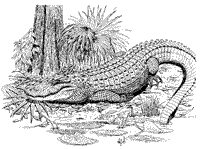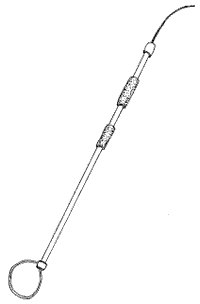|
Alligators | Alligator Overview | Alligator Damage Assessment | Alligator Damage Management | Alligator Resources | Alligator Acknowledgments | ICWDM | Wildlife Species Information |
Contents |
Damage Prevention and Control Methods
Exclusion

Alligators are most dangerous in the water, or at the water’s edge. They occasionally make overland forays in search of new habitat, mates, or prey. Concrete or wooden bulkheads that are a minimum of 3 feet (1 m) above the high-water mark will repel alligators along waterways and lakes. Alligators have been documented to climb 5-foot (1.5-m) chain-link fences to get at dogs. Fences at least 5 feet high with 4-inch (10-cm) mesh will effectively exclude larger alligators if the top of the fence is angled outward.
Habitat Modification
Elimination of wetlands will eradicate alligators because they depend on water for cover, food, and temperature regulation. Most modifications of wetlands, however, are unlawful and would adversely affect other wildlife. Elimination of emergent vegetation can reduce alligator densities by reducing cover. Check with appropriate conservation authorities before modifying any wetlands.
Frightening
Aversive conditioning using sticks to prod “tame” alligators and rough handling of captured alligators have been attempted in several areas with limited success. Hunting pressure appears to be the most effective means of increasing alligator wariness and may be responsible for limiting the incidence of alligator attacks in Florida, despite increasing human and alligator populations. The historically low attack rate in Louisiana is attributed to a history of intense hunting.
Repellents
None are registered.
Toxicants
None are registered.
Trapping
Alligators can be readily trapped because they are attracted to baits. A baited hook is the simplest method and is used in Louisiana as a general harvest method, and in Florida to remove nuisance alligators. Hooks are rigged by embedding a large fish hook (12/0 forged) in bait (nutria, fish, beef lungs, and chicken are popular), and suspended from a tree limb or pole about 2 feet (0.6 m) above the surface of the water. The bait should be set closer to the water to catch smaller alligators. To increase success, baited hooks should be set in the evening and left overnight during the primary feeding time of alligators. Once swallowed, the hook lodges in the alligator’s stomach and the alligator is retrieved with the attached rope. This method can kill or otherwise injure alligators, and is not suitable for alligators that are to be translocated. Hooked alligators are most effectively killed by a shot to the brain with a small caliber (.22) rifle. Powerheads (“bangsticks”) can also be used to kill alligators, but should only be used with the barrel under water and according to manufacturer recommendations.
Trip-snare traps (Fig. 2) are more complicated and somewhat less effective than are set hooks, but do not injure or kill alligators. An alligator is attracted to the bait and, because of the placement of the guide boards, is forced to enter from the end of the trap with the snare. The alligator puts its head through the self-locking snare (No. 3, 72-inch [1.84-m]; see Supplies and Materials), seizes the bait, and releases the trigger mechanism as it pulls the bait. The surgical tubing contracts and locks the snare on the alligator. These traps can be modified as floating sets. A variation of the trip-snare trap can be set on alligator trails and rigged to trip by the weight of the alligator (see Mazzotti and Brandt 1988).
Wire box traps have been used effectively to trap alligators. Heavy nets have been used with limited success to capture alligators and crocodiles at basking sites.
Translocation
Translocation of problem alligators was practiced extensively during the 1970s with limited success. Alligators, especially larger ones, tended to return to their original capture sites after being moved. These alligators not only caused problems during their return trip, but frequently required subsequent capture and translocation. Translocation is not recommended unless areas with depleted alligator populations are available for release of problem animals.

Shooting
Next to baited hooks, shooting is probably the most effective means of removing alligators. Alligators can be shot during the day or at night, and should be shot in the brain case with a sufficiently powerful rifle (.243 caliber and larger) for an efficient and humane kill. Firearms, however, present public safety problems in most nuisance alligator settings. Furthermore, alligators sink almost immediately after dying and may be difficult to recover (by gaffs or snatch hooks) in areas with currents or dense submerged plants. This method may make confirmation of a kill difficult and may compromise the commercial value of the alligator. Crossbows with lines attached to barbed bolts work fairly well at short distances, but should only be used to kill alligators.

Other Methods
Detachable-head harpoons with attached lines have been used effectively to harvest nuisance alligators. A harpoon assembly (Fig. 3a) is attached to a 10- to 12-foot (3- to 3.5-m) wooden pole. The harpoon is thrust at the alligator, and after the tip penetrates the skin, withdrawn, leaving the tip embedded under the alligator’s skin (Fig. 3b). As tension is placed on the retrieval line, the off-center attachment location of the cable causes the tip to rotate into a position parallel to the skin of the alligator, providing a secure attachment to the alligator. Harpoons are less effective than firearms, but the attached line helps to ensure the recovery of the alligator.
Snatch hooks are weighted, multi-tine hooks on fishing line that can be cast over an alligator’s back and embedded in its skin. The size of hooks and the line strength should be suited to the size of the alligator. Small alligators can be caught with standard light fishing gear, while large alligators require 10/0 hooks, a 100-pound test line, and a heavy-duty fishing rod. Heavy hooks with nylon line can be hand-cast for larger alligators. After the hook penetrates the alligator’s skin, the line must be kept tight to prevent the hook from falling out. Alligators frequently roll after being snagged and become entangled in the line. This entanglement permits a more effective recovery. Snatch hooks work well during the day and at night, provided that vegetation is minimal.

Hand-held poles with self-locking snares (sizes No. 2 and 3; Fig. 4) can be used effectively to capture unwary alligators at night. For smaller (less than 6 feet [1.8 m]) alligators, snares can be affixed to a pole with a hose clamp. For adult alligators, snares should be rigged to “break away” from the pole by attaching the snare to the pole with thin (1/2-inch [1-cm] wide) duct tape (Fig. 4). The tape or clamps allow the snare to be maneuvered and are designed to release after the snare is locked. Carefully place the snare around the alligator’s neck, then jerk the pole and/or retrieval line to set the locking snare. A nylon retrieval rope should always be fastened to the snare and the rope secured to a boat or other heavy object.
Figure 5. Commercial catch pole. Figure 6. Snake tongs.


For alligators less than 6 feet (1.8 m) long, commercially-available catch poles (Fig. 5; see Supplies and Materials) can be used. Snake tongs (Fig. 6, see Supplies and Materials) are effective for catching alligators less than 2 feet (0.6 m) long.
Avoidance
Measures can be taken to avoid confrontations with alligators and substantially reduce the probability of attacks. Avoid swimming or participating in water activities in areas with large alligators. Avoid water activities at dusk and at night during the warmer months when alligators are most active. Alligators can quickly surge at least 5 feet (1.5 m) onto the shore to seize prey, so care should be taken when at the water’s edge. Do not feed alligators. Avoid approaching nests and capturing young (<2 feet [0.6 m]) alligators.
|
Alligators | Alligator Overview | Alligator Damage Assessment | Alligator Damage Management | Alligator Resources | Alligator Acknowledgments | ICWDM | Wildlife Species Information |
